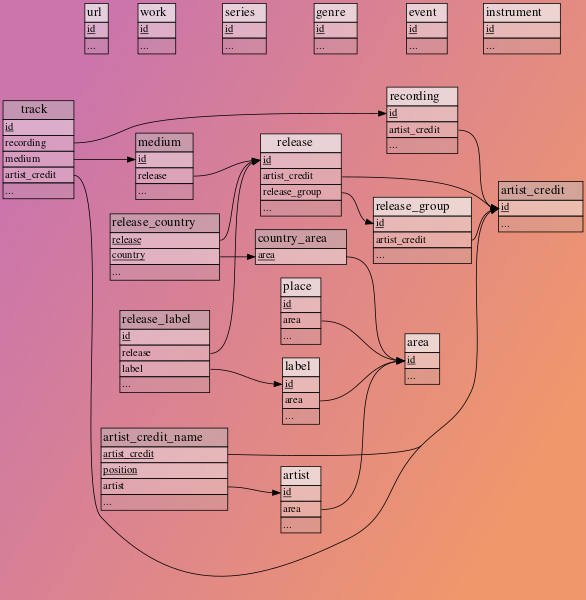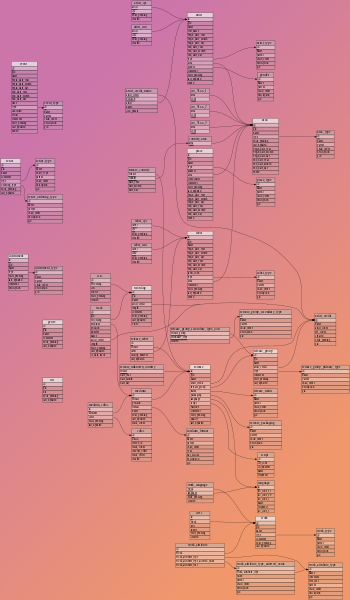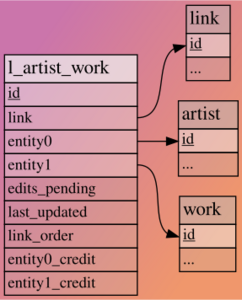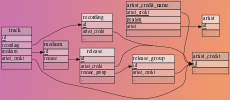MusicBrainz Database / Schema
| Status: This page is a work in progress. |
This page is intended for developers querying the MusicBrainz database directly through PostgreSQL.
Overview
The SQL scripts that create the schema can be found in our source code repository.
The database is structured around primary entities which can be edited, searched for, referred to by MBID, and linked to each other through relationships or foreign key constraints in some case. Secondary entities cannot be linked through relationships, instead they are directly linked through foreign key constraints only. Each primary entity type has a main table sometimes accompanied by complementary tables of which a few are unique but most are common.
- The first diagram below shows the main tables for primary entity types and unique tables connecting these tables, that is, beyond relationships. The main tables are highlighted. All tables are shortened to focus on foreign key constraints.
- The second diagram additionally shows the main tables for primary entity types and tables unique to some of these, that is, beyond aliases, annotations, edits, redirects, relationships, ratings, tags.
- The third diagram shows all the tables but is too dense to just distinguish foreign key constraints for example, thus the many following sections.
Primary entities
Each primary entity has a main table with the same name as the entity, containing its basic data.
Area
 | A country, region, city or the like. Areas that can be used for filling in the Release country field of releases are listed, by ID, in the The table |
Artist
 | An artist is generally a musician, a group of musicians, or another music professional (composer, engineer, illustrator, producer, etc.) The tables |
Event
 | An event refers to an organised event which people can attend, and is relevant to MusicBrainz. Generally this means live performances, like concerts and festivals. |
Genre
 | A genre is a descriptor for the style and conventions followed by a piece of music. |
Instrument
 | Instruments are devices created or adapted to make musical sounds. We also list common instrument groupings (such as string quartet) as instruments. |
Label
 | Labels represent mostly (but not only) imprints. |
Place
 | A venue, studio or other place where music is performed, recorded, engineered, etc. |
Recording
 | Represents a unique mix or edit. Has title, artist credit, duration, list of ISRCs. Examples (all are different Recordings):
The table |
Release
 | Real-world release object you can buy in your music store. It has release date and country, list of catalog number and label pairs, packaging type and release status. Examples:
The tables |
Release group
 | Represents an abstract "album" (or "single", or "EP") entity. Technically it's a group of releases, with a specified type. Examples:
The table |
Series
URL
| This entity represents a URL pointing to a resource external to MusicBrainz, i.e. an official homepage, a site where music can be acquired, an entry in another database, etc. |
Work
Secondary entities
Each secondary entity has a main table with the same name as the entity, containing its basic data.
Artist credit
List of artists, variations of artist names and pieces of text to join the artist names. Examples:
- "Queen & David Bowie" -- two artists ("Queen" and "David Bowie"), no name variations, joined with " & "
- "Jean-Michel Jarre" -- one artist ("Jean Michel Jarre"), name variation "Jean-Michel Jarre"
- "Tracy W. Bush, Derek Duke, Jason Hayes and Glenn Stafford" -- four artists, no name variations, joined with commas and an "and".
Medium
This entity represents a piece of media, included in a release. It contains information about the format of the media, its position in the release, an optional title, and most importantly, a list of tracks. CD TOCs are attached to mediums, not releases or release_groups.
Examples:
- CD1 of the 1984 US release of "The Wall" by "Pink Floyd"
- CD2 of the 2005 UK release of "Aerial" by "Kate Bush", named "A Sky of Honey"
Track
This entity is not visible to users on its own, only in the context of a release. It has an MBID, and contains a link to a recording, a title, artist credit and position on its associated medium.
Entity complementary data
Aliases
All the primary entities except URL (i.e. area, artist, event, genre, instrument, label, place, recording, release, release group, series and work) have *_alias tables, all of which have the same structure. They contain alternate names for instances of those entities.
Annotations
All the primary entities except URL (i.e. area, artist, event, genre, instrument, label, place, recording, release, release group, series and work) have a corresponding *_annotation table that links entities of that type to entries in the main annotation table which contains the actual text of the annotation, along with the changelog and the identity of the editor who created it.
Edits
Edits to the database are stored in edit table, with the edit notes/comments stored in edit_note. The 13 other edit_* tables are used to link edits to the entity they modify; there is one such table for each primary entity type. They all have the same structure: just two foreign keys, one to the entity table and the other to edit table.
IPIs and ISNIs
The primary entities artist and label can have multiple IPI and ISNI codes attached to them. These tables *_ipi and *_isni are used to store those mappings. They contain a foreign key pointing to the entity, the actual value of the code, and edits_pending and created fields with the usual meaning.
MBID redirects
There are 15 *_gid_redirect tables, one for each of the 13 primary entity types, plus ones for track and artist_credit. They are used to redirect one MBID to another when entities are merged.
Ratings
There is one *_rating_raw table for each of the primary entities that can be rated: artist, event, label, place, recording, release group and work. The *_rating_raw tables all have the same structure, consisting of the actual rating, expressed as an integer between 0 and 100, and two foreign keys, one linked to the associated entity, and the other linked to the editor table, to specifying who made the rating. For privacy reasons, the *_rating_raw tables aren't included in the database dumps.
The aggregate rating of each entity is stored in the corresponding _meta table, in the rating field. There is also a rating_count field that specifies how many ratings have been entered for the entity.
The release_group_meta table also contains other fields, and the release entity, even though it cannot be rated, still has a release_meta table, which is used to store other data.
Tags
All primary entities but the genre and URL (i.e. area, artist, event, instrument, label, place, recording, release, release group, series and work) have *_tag and *_tag_raw tables, with the same structure. These tables contain two foreign keys, linked to the associated entity and to the tag table. The *_tag_raw tables contain a foreign key, editor, which specifies who added the tag, while the *_tag tables instead contain a count of how many times a tag is applied to a particular entity, and a last_updated timestamp. For privacy reasons, the *_tag_raw tables aren't included in the database dumps.
The tag table contains the actual names of the tags, and a ref_count indicating how often the tag has been used.
Types
*_type tables are simply mappings between strings and ID numbers, representing various sets of types. Areas, artists, events, instruments, labels, places, series and works are the only primary entities with each have a *_type and an *_alias_type table. Release groups have release_group_primary_type and release_group_secondary_type tables. Genres, recordings and releases only have *_alias_type tables, and URLs do not have *_type tables at all.
Relationship table structure
The first below diagram shows minimal foreign keys needed to define a relationship between two entities. Artist-Work is just an example of a relationship type. The main table is highlighted. All other tables are shortened to focus on foreign key constraints. The second diagram complementarily shows tables for the detailed representation of a link. The main tables are highlighted.
l_* tables
There are tables for every possible combination of the primary entities (area, artist, event, instrument, genre, label, place, recording, release, release_group, series, url and work) all prefixed with l_ and all with the same format. Two of them are shown in the diagram. They contain a field, edits_pending that is a count of pending changes to the AR, a last_updated field, and three foreign keys: link that points back to the associated entry in the link table, and entity0 and entity1 that point to the associated entry in the corresponding entity table (i.e. artist, recording, url, etc.).
There are two tables that help to avoid unnecessary duplication:
link & link_attribute tables
The link table contains the begin and end date info, and the link_type foreign key field that specifies what kind of AR it is. It also has a count of how many other attributes that particular link has in the attribute_count field, and a created field that specifies when it was created.
Each AR attribute either applies to a particular AR or it doesn't. The link_attribute table stores this information, having a record for each attribute_type (a foreign key field for link_attribute_type) of each link.
link_type, link_attribute_type, & link_type_attribute_type tables
The AR types and attributes are defined in these three tables, shown at the top of the diagram. They can only be modified by the AR editors.
The link_type table defines the types of ARs available. AR types are arranged in a number of trees, for ease of finding. This tree structure is expressed with the parent and child_order fields; parent is the id of the parent AR type, or null if it's at the root, and child_order orders the children of a given parent AR type. Each AR type has a unique uuid, stored in the gid field, for use in permalinks and external applications. The link between a particular AR type and the corresponding l_ table is formed by the entity_type0 and entity_type1 fields.
The attributes are themselves defined in the link_attribute_type table. Like AR types, attributes form a number of trees (the vast majority of them are individual musical instruments). Besides the parent and child_order fields shared with the link_type table, the link_attribute_table also has a root field, showing the root of the tree that the attribute is part of. Attributes also have names and descriptions which appear in various places where they are displayed, as well as gids and a last_updated timestamp.
The link_type_attribute_type table specifies what attributes can be applied to particular types of ARs; it has the necessary foreign key fields (link_type and attribute_type) and it also specifies how many instances of the attribute (or one of its children) can be added to the particular AR type in the min and max fields. Currently, most of them allow the attributes to merely be present or absent, while a few allow any number of copies of the attribute, or none. The "creative commons licensed download" attribute has to be included exactly once, while the instrument attribute (of the instrument type AR), requires at least one instance.
Cover Art Archive table structure
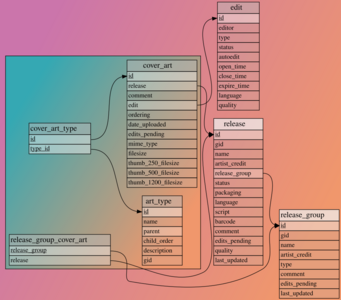 | The Cover Art Archive table structure is fairly simple. The cover_art table stores the actual cover art and associations to edits. art_type stores the acceptable cover art types, and cover_art_type links the two together. release_group_cover_art links a release group to the release whose cover art should represent the release group. This image also shows the links to tables in the main diagram (as well as the edit table), but not their full schemas; please see other diagrams or the real schema specification for details. There is one view not shown, which is the index_listing view -- this makes for a slightly nicer interface than joining the tables manually, by providing an array of cover art types and easy pointers for is_front and is_back. Otherwise it largely resembles the cover_art table. |
CDStubs table structure
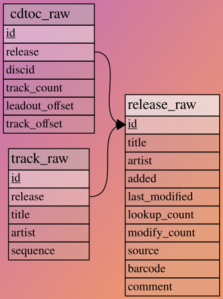 | The CDStubs table structure consists of only 3 tables: cdtoc_raw, release_raw and track_raw. The release_raw table contains basic metadata about the stub release, such as the artist and title. The individual tracks of each stub release are in the track_raw table, which holds the track title and its track number (in the sequence column). A track's artist can be different than the artist of the release, so there's an artist column which can optionally contain the name of the track's artist. Each CDStub needs an associated Disc ID, which is stored in the cdtoc_raw table, together with the track count of the disc, as well as the leadout and track offset (Disc ID Calculation contains more information about the latter two). |
Frequent use cases
Tagging audio files
Finding song authors
Undocumented tables
The following tables have not yet been documented in this page. Help is gratefully appreciated!
CREATE TABLE artist_credit_name CREATE TABLE cdtoc CREATE TABLE gender CREATE TABLE iso_3166_1 CREATE TABLE iso_3166_2 CREATE TABLE iso_3166_3 CREATE TABLE isrc CREATE TABLE iswc CREATE TABLE language CREATE TABLE link_creditable_attribute_type CREATE TABLE link_attribute_credit CREATE TABLE medium_cdtoc CREATE TABLE medium_format CREATE TABLE medium_index CREATE TABLE release_country CREATE TABLE release_unknown_country CREATE TABLE release_coverart CREATE TABLE release_label CREATE TABLE release_packaging CREATE TABLE release_status CREATE TABLE release_group_secondary_type_join CREATE TABLE replication_control CREATE TABLE script CREATE TABLE script_language CREATE TABLE tag_relation CREATE TABLE work_attribute_type CREATE TABLE work_attribute_type_allowed_value CREATE TABLE work_attribute
The following tables are not publicly available for download thus are not relevant in this page.
CREATE TABLE application CREATE TABLE autoeditor_election CREATE TABLE autoeditor_election_vote CREATE TABLE edit_note_change CREATE TABLE editor CREATE TABLE editor_collection CREATE TABLE editor_collection_release CREATE TABLE editor_language CREATE TABLE editor_oauth_token CREATE TABLE editor_preference CREATE TABLE editor_subscribe_artist CREATE TABLE editor_subscribe_artist_deleted CREATE TABLE editor_subscribe_collection CREATE TABLE editor_subscribe_label CREATE TABLE editor_subscribe_label_deleted CREATE TABLE editor_subscribe_editor CREATE TABLE editor_subscribe_series CREATE TABLE editor_subscribe_series_deleted CREATE TABLE unreferenced_row_log CREATE TABLE vote
